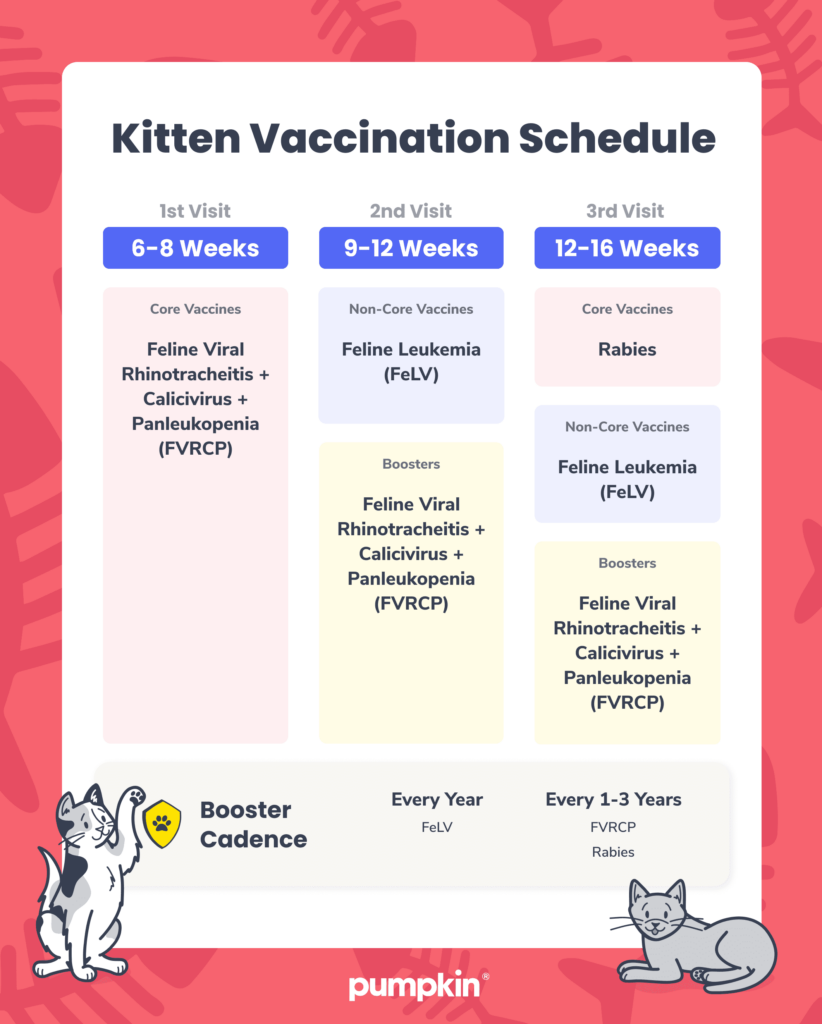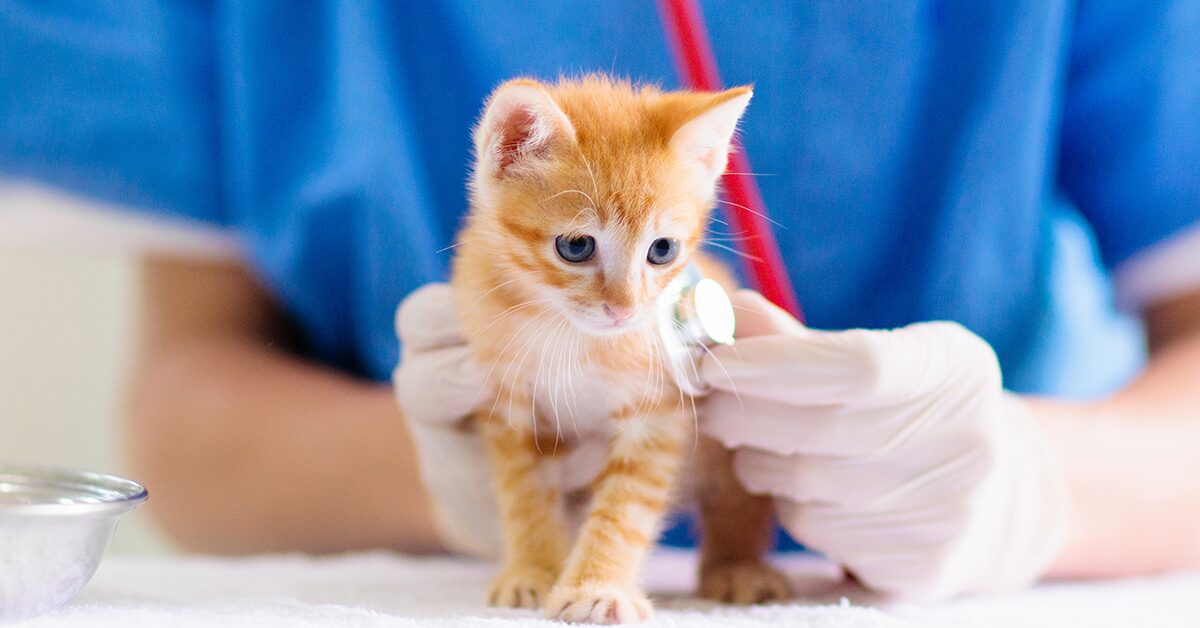Key Points
- Feline leukemia virus, or FeLV, is an infectious disease that affects 2-3% of cats in the United States. It’s more common in younger cats and cats that spend a lot of time outdoors.
- FeLV can weaken your cat’s immune system, leading your cat to develop secondary illnesses and infections, and can also potentially cause cancers such as lymphoma.
- Disease can be spread through all bodily secretions, including saliva, mucus, urine and feces, and even mother’s milk – it’s possible for an infected mother cat to spread the disease to her babies while nursing.
- There aren’t targeted treatments for FeLV; instead, most veterinary care focuses on improving wellness and fighting secondary illnesses.
Cat parents only want what’s best for their fur babies – so the thought of a long-term, potentially incurable disease affecting their beloved cat is enough to keep most up at night. But like any illness, it’s important to have all of the facts.
Feline leukemia virus, or FeLV, is a common but serious ailment in domestic cats. It’s an infectious disease, spreading from one sick feline to another, and potentially causing secondary infections.
If your cat is exposed to a FeLV-positive cat, you should get them tested immediately. If they start displaying symptoms of illness, don’t delay and take them to the vet.
Symptoms
The symptoms of FeLV are numerous, but some symptoms include:
- Loss of appetite
- Weight loss
- Fever
- Pale gums
- Diarrhea
You might also observe your cat’s coat becoming dirty, or notice them developing eye infections.
FeLV can also cause immune deficiency, making your cat more susceptible to other infections. This can lead to gingivitis and stomatitis (infections of the gums and mouth, respectively) and infections of the skin, bladder, urinary tract, and upper respiratory tract. In other words, one infectious disease leads to other infectious diseases.
More serious symptoms may include seizures and other neurological problems, enlarged lymph nodes, and miscarriages in pregnant cats. FeLV can also cause cancers like lymphoma and blood disorders when untreated. That’s why it’s important to bring your cat to the vet right away if you notice them displaying the above symptoms. It’s better to be safe than sorry.
Causes
FeLV is an infectious disease, so it’s spread from cat to cat. If your cat isn’t interacting with other cats on a regular basis, they’re less likely to contract FeLV.
The virus can be transmitted through numerous bodily secretions, including:
- Saliva
- Mucus and other nasal secretions
- Urine
- Feces
- Mother’s milk
FeLV may be transmitted during activities like:
- Fighting (biting and scratching)
- Mutual grooming
- Shared use of litter boxes or food dishes (more rarely)
- In utero or during nursing
Additionally, the following factors may make a cat more susceptible to FeLV:
- Age – older adult cats seem to be less susceptible than younger cats
- Time spent outdoors – indoor cats are less likely to contract the disease unless they belong to a multi-cat household.
Diagnosis
After your vet has observed the potential symptoms of FeLV, there are two common blood tests they may order to determine whether a cat has been infected with FeLV:
- Enzyme-linked immunosorbent assay (ELISA), which is generally performed first in a vet’s office and tests for free FeLV particles in the cat’s bloodstream.
- Indirect immunofluorescent antibody assay (IFA), which is performed after using ELISA as a screening tool to detect virus particles in white blood cells.
- In some cases, a polymerase chain reaction (PCR) test may be used to determine whether the cat’s bone marrow has been infected.
In most cases, a cat who tests positive for FeLV on the IFA test will remain infected for life. A positive PCR test indicates that the virus has progressed to a more serious stage.
Treatment
Sadly, there is no specific treatment for feline leukemia virus. Although there are therapies that may reduce the concentration of FeLV particles in the cat’s bloodstream, these aren’t effective in all cases.
However, secondary infections and conditions which develop as a result of the disease may be treated with supportive care. For instance:
- Infections that take advantage of immune suppression as a result of feline leukemia virus may be treated with antibiotics.
- If a cat develops cancerous growths as a result of feline leukemia virus, chemotherapy may be possible.
- Blood transfusions may be necessary in cases of anemia.
Since there’s no way of curing FeLV at present, treatment of secondary infections and other symptoms is the best veterinary science can offer. Of course, your love and care can do wonders to help your kitty feel better no matter what life throws your way.
Recovery and care
As there is no targeted treatment for FeLV, treatment is more focused on management and improving quality of life than on curing the disease or seeking full recovery. 85% of cats infected with FeLV do not survive longer than three years after diagnosis, with the prognosis being worse for cats with positive IFA and PCR tests – even if, from the outside, they look perfectly healthy.
However, there are steps you can take to give your cat the best quality of life possible during the time that they have. Twice-yearly exams, including testing for opportunistic infections and parasite control, help to prevent your cat from excessive suffering. Simply doing what you can to keep your cat happy is the best course of action.
Prevention
Thankfully, there is a vaccine for feline leukemia virus. It consists of two injections and regular boosters to keep up immunity. However, like all vaccines, it’s not 100% effective, and it’s not considered a core vaccine by veterinarians. Before giving your cat the vaccine, discuss with your veterinarian the likelihood of their exposure to FeLV, and make sure they test negative for FeLV before they receive the injections.
The most effective method of prevention besides the vaccine is to limit your cat’s exposure to potential infection vectors. This means keeping them indoors and away from FeLV-positive cats. You should get your cat tested if there’s a risk they’ve been exposed, even if they’re vaccinated, and get them tested whenever they’re sick.

What to expect at the vet’s office
Come prepared to the vet’s office with a list of your cat’s symptoms and possible exposures. Your vet will likely order a FeLV test for your cat, beginning with ELISA, which can be performed in-office. If there are FeLV particles in your cat’s bloodstream, the test will likely return a positive result, and the veterinarian may order an IFA test to be conducted at a diagnostic laboratory facility. After the results are received, your vet will be able to give you an accurate prognosis and care plan.
The bottom line
Feline leukemia virus is a serious disease and one that doesn’t have clear treatment options at the moment. At the same, there is still a lot you can do for your cat if they become infected. The most important thing you can do is bring them to the vet for regular checkups and care for them if they develop a disease that takes advantage of the infection.
You should make sure to get your cat vaccinated while they’re young. Even if the vaccine isn’t one hundred percent effective, it provides them with the best protection currently available to protect against the disease. Even with the vaccine, try to limit your cat’s exposure to potential disease vectors, and be sure to get them tested regularly for FeLV.
FAQs
Is FeLV curable?
There is currently no cure for FeLV, and no targeted treatments. But with the right care, it is possible to give your cat a high quality of life.
How long do most cats live after being diagnosed with feline leukemia virus?
In most cases, cats survive two to three years after their diagnosis. However, this depends on how well the cat’s health is maintained during this period, including preventing secondary infections and illnesses.
Will pet insurance cover the FeLV vaccine?
Unfortunately, in most cases, pet insurance does not cover preventive care including vaccines. However, pet insurance can in some cases cover treatment and management of illnesses that result from FeLV infection.
Can FeLV particles survive outside of a cat’s body?
FeLV particles usually don’t survive longer than a few hours outside the body of a cat, so you don’t need to worry about indirect exposure.
Did you know
- Wild cats such as lions can also be infected with FeLV.
- About 30% of cats who encounter FeLV are able to beat the infection with their own immune system and avoid contracting the disease.
- Pumpkin Preventive Essentials can help you pay for vital routine care like annual check-up fees, parasite screenings, and key vaccines. This is not insurance, but an optional wellness package that can help set your cat up for a happy, healthy life.
- https://www.vet.cornell.edu/departments-centers-and-institutes/cornell-feline-health-center/health-information/feline-health-topics/feline-leukemia-virus
- https://vcahospitals.com/know-your-pet/feline-leukemia-virus-disease-complex
- https://www.merckvetmanual.com/cat-owners/disorders-affecting-multiple-body-systems-of-cats/feline-leukemia-virus-felv



